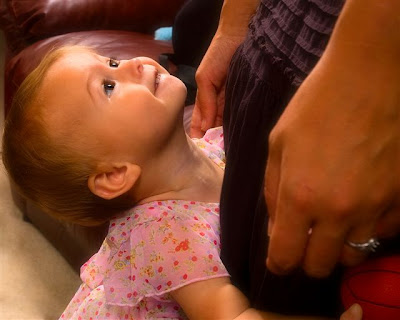 This month's Photographer in the Spotlight introduces Phil Jern of Indianapolis, a longtime shooter who beg
This month's Photographer in the Spotlight introduces Phil Jern of Indianapolis, a longtime shooter who beg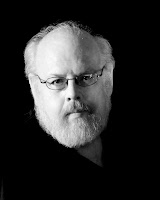 an his craft when he was recruited to work on the yearbook at Thomas Carr Howe High School on the Eastside of Indianapolis some 40 years ago or so. One of the photos Jern took in those years, an exterior shot of the high school, is among pictures he keeps in a set of family images at his Flickr stream site.
an his craft when he was recruited to work on the yearbook at Thomas Carr Howe High School on the Eastside of Indianapolis some 40 years ago or so. One of the photos Jern took in those years, an exterior shot of the high school, is among pictures he keeps in a set of family images at his Flickr stream site.The native of Urbana, Ill., left for the U.S. Army in 1972, serving in Thailand, Hawaii, Berlin and Ethiopia. When he was on duty, Jern said, he could not travel with a camera due to the nature of his duties, something he said he's always regretted. "Most of the locations and projects I worked in/at were classifed areas." But when he was off duty, he more t
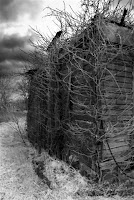 han made up for it and amassed a large collection of images. That collection met an unfortunate fate, something Jern will discuss in our interview.
han made up for it and amassed a large collection of images. That collection met an unfortunate fate, something Jern will discuss in our interview.When he's not practicing his craft, Jern does programming for private business clients and runs a small expedited freight contracting service.
I met Phil, the first of several Indianapolis photographers I intend to introduce here in the coming months, through CaptureIndy, a photographic book publishing project driven by The Indianapolis Star that is still in the process of collecting prospective images from area photographers to use in the book.
Phil, your bio page at your Web site indicates you got into photography when you were in high school, working for the school newspaper and yearbook. How did you end up doing photographic work for the newspaper and yearbook staff? Were you recruited? Was there a learning curve involved? If so, how did that go and work? Did your high school
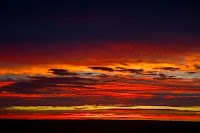 offer any journalism, writing and/or photography courses?
offer any journalism, writing and/or photography courses?
I went to high school at Thomas Carr Howe High School, Class of 1972. Like most things, the story starts with people -- a couple of good, interested teachers who were willing to spend time with students above and beyond the call of duty. We had journalism classes, and people for the yearbook/paper were recruited from there. As I recall, they fell under the English department. I don't recall any special photography courses, although I did get sort of taken under the wing of the pro who shot the school portraits -- he taught me film 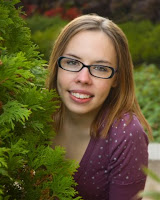 developing, for example. A lot of my learning was self-directed; I've always had an autodidactic streak. I spent a lot of time in the library reading Ansel Adams, etc.
developing, for example. A lot of my learning was self-directed; I've always had an autodidactic streak. I spent a lot of time in the library reading Ansel Adams, etc.
Speaking of Adams, I'll ask you another question I ask all the shooters in my Q&A features: Do you have any favorite photographers -- either whose work you've followed locally or from afar through the years ... or who may have inspired you to a significant degree?
Well, photographers and artists ... Adams, Jerry Uelsmann, any number of the National Geographic pros over the years. Weegee and his New York crime scene photos. There's an immediacy there that's compelling. O. Winston Link and his photos from the last days of steam on the Norfolk and Western Railroad is a particular favorite.
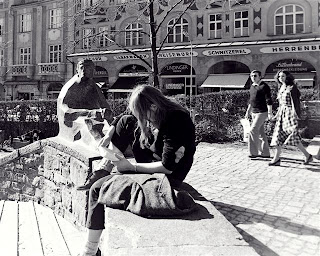 How was it that you ended up living in so many places in the world ... and that you ended up back in Indianapolis? Do you have a lot of images from your world travels?
How was it that you ended up living in so many places in the world ... and that you ended up back in Indianapolis? Do you have a lot of images from your world travels?
Well, most of that travel was courtesy of Uncle Sam. I lived in Thailand, Germany and Hawaii and visited many other countries in the course of my duties. I don't have as many images as one would think, partially because a container with my belongings was lost overboard during a move, and I lost about 20,000 negatives and slides. That was so personally devastating to me that I quit altogether for a number of years. I eventually came back here to be closer to my children.
You are my first Indianapolis profile for this feature, so considering you've done a lot of traveling,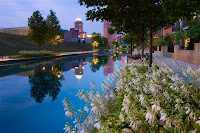 I thought you'd be a good person to ask the following: How would you size up Indianapolis and its community as photographic subjects -- its people, places, landscapes, charm -- or any other attribute you can think of? Are there any shoots of yours locally in particular you are most pleased with? Have you had any hellacious experiences on a local shoot?
I thought you'd be a good person to ask the following: How would you size up Indianapolis and its community as photographic subjects -- its people, places, landscapes, charm -- or any other attribute you can think of? Are there any shoots of yours locally in particular you are most pleased with? Have you had any hellacious experiences on a local shoot?
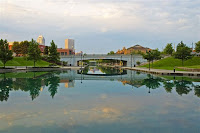 Indianapolis has lots to offer the photographer -- everything from the quiet gardens of the art museum to the downtown canal (one of my favorite places!) to beautiful parks and the public gardens at Garfield Park. There are great people here, too. If you can't find something interesting to shoot here, you're not even trying! I've never had a problem shooting here, although I've run across some ... unusual people.
Indianapolis has lots to offer the photographer -- everything from the quiet gardens of the art museum to the downtown canal (one of my favorite places!) to beautiful parks and the public gardens at Garfield Park. There are great people here, too. If you can't find something interesting to shoot here, you're not even trying! I've never had a problem shooting here, although I've run across some ... unusual people.
How difficult, or easy, was it for you to make the transition into digital photography? Do you still dabble in film? If so, do you also do your own lab work? I've chatt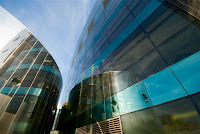 ed recently with people who did lots of film work and are lamenting the disappearance (and staying/preservation power) of Kodachrome. Are you one of those?
ed recently with people who did lots of film work and are lamenting the disappearance (and staying/preservation power) of Kodachrome. Are you one of those?
Digital photography was hard for me, at first. I dabbled with the early cameras before 2001 or so and decided that it wasn't ready for prime time, so I stuck with my 25-year-old Minolta. I made a couple forays into point and shoots, but it wasn't until the Nikon D70/Canon Rebel era that I got interested in digital again.
I still have one film camera -- a Nikon N80. I haven't used it in a while. I ha ve no room or desire to have a wet lab again. With reference to Kodachrome: I never used it much, having at one time a preference for the Agfa and Fuji colors. I did tons of Ektachrome over the years.
ve no room or desire to have a wet lab again. With reference to Kodachrome: I never used it much, having at one time a preference for the Agfa and Fuji colors. I did tons of Ektachrome over the years.
Digital files have the possibility of being preserved for a very long time if we work at it. I remember early Sony cams that got one photo on a floppy disk, and now we get tens of thousands on cheap hard disks -- so cheap that I keep all my stuff backed up on three separate drives.
You use your Web site not only to display the cream of your work but, it seems, to instruct and enc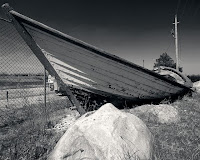 ourage. I remember seeing, for example, a reference to how one of the best pieces of advice you could give a photographer is to shoot close and shoot wide (see accompanying images of the longboat and "roadkill view" front auto grill). Do you really think in those terms when you approach every shot before deciding if it is the best approach for that shot?
ourage. I remember seeing, for example, a reference to how one of the best pieces of advice you could give a photographer is to shoot close and shoot wide (see accompanying images of the longboat and "roadkill view" front auto grill). Do you really think in those terms when you approach every shot before deciding if it is the best approach for that shot?
Most of the time, I try to. I do apply generalities, however. Indoors, for example, I'm likely to shoot wide-angle just because of the limited room, and I'm going to be close anyway. For flowers, I know I'm going to probably use something in the 150-300mm range, to isolate and decrease depth of field. For architecture and outside scenes, I try to let the subject dictate what I use.
however. Indoors, for example, I'm likely to shoot wide-angle just because of the limited room, and I'm going to be close anyway. For flowers, I know I'm going to probably use something in the 150-300mm range, to isolate and decrease depth of field. For architecture and outside scenes, I try to let the subject dictate what I use.
"Get Close and Go Wide" works for me. It's one of my personal philosophies because I feel it opens up a lot of relational space in the frame. It might not work for everyone, but I feel like a lot of photos don't live up to their potential with a more timid approach.
Many photographers have a vision of the final product before, or as, they set up the picture. You allude to that a couple times, for example, in the captions of some of the rural or abandoned building shots that I saw at your Web site. Would you say you're able to do that most of the time? If not, what percentage of the time do you not decide how to process, or finish, an image in post-processing until you have it up on your editing software?
 Well, it's easy enough to say that black-and-white post-processing is going to be where something is going to end up if it's a monochromatic subject with interesting textures and contrast. Sometimes, I'll switch horses midstream, playing on Photoshop with different crops or contrast curves, to see what works best. I have a bunch of non-standard tool settings that I've developed that fit my style. I'd say it's probably 75 percent pre-planned and 25 percent serendipity.
Well, it's easy enough to say that black-and-white post-processing is going to be where something is going to end up if it's a monochromatic subject with interesting textures and contrast. Sometimes, I'll switch horses midstream, playing on Photoshop with different crops or contrast curves, to see what works best. I have a bunch of non-standard tool settings that I've developed that fit my style. I'd say it's probably 75 percent pre-planned and 25 percent serendipity.
Regarding t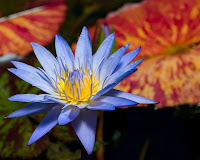 he challenge to shoot wide and close ... what kind of wide-angle lens options do have to pick from? Do you have a favorite? And speaking of equipment, what types of camera bodies do you have and/or use regularly? And is any one of those also your all-time favorite? If not, what is?
he challenge to shoot wide and close ... what kind of wide-angle lens options do have to pick from? Do you have a favorite? And speaking of equipment, what types of camera bodies do you have and/or use regularly? And is any one of those also your all-time favorite? If not, what is?
I don't actually own a wide variety of lenses. The 18mm setting on my 18-70 kit lens is often wide enough, and if not, I go to my Sigma 10-20. The 10-20mm is my go-to lens for automobile photography. I use Nikon bodies; for me it's strictly a matter of ergonomics -- they feel better in my hand. I try not to overspend on equipment: I still have and use a D50. My main camera is a D80. I never take sides in the brand warfare; I think everyone should choose their cameras for their own reasons.
I recently read through a lengthy photo group discussion thread at an online business networking site ("Linked-In, if you're familiar with it). A group member asked fellow photographers if and when a photograph can be labeled "fine art." Some shooters said that the degree of photo editing involved in post-processing determined the definition for them. How do you feel about pictures -- images -- being classified as "fine art?" Do you think all images can be termed fine art, and if you think not, at what point does an image become fine art?
if you're familiar with it). A group member asked fellow photographers if and when a photograph can be labeled "fine art." Some shooters said that the degree of photo editing involved in post-processing determined the definition for them. How do you feel about pictures -- images -- being classified as "fine art?" Do you think all images can be termed fine art, and if you think not, at what point does an image become fine art?
Art is a subjective term, and "fine art" is an over-qualification. Beauty is in the eye of the beholder,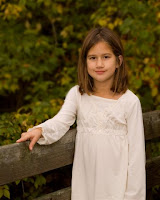 and art is something intangible. It's inherent in what you see in something. I believe everyone has the innate capability to be an artist in some manner, and I'd be the last person to draw a line as to where art starts or ends.
and art is something intangible. It's inherent in what you see in something. I believe everyone has the innate capability to be an artist in some manner, and I'd be the last person to draw a line as to where art starts or ends.
Along the same line, when you do your post-processing, do you have a personal "rule" or line that you don't cross when it comes to enhancing images? Also what Photoshop features do you find yourself either utilizing -- or appreciating -- the most? Are there any other photo editing software programs you use regularly and/or regard as important or crucial in your workflow? Lightroom, for example? Or any of the noise-removal programs (or plug-ins)?
I try not to get too heavy-handed, and try to avoid the standard "art" filters that come with programs like Photoshop. I'm more "nuts and bolts" in my approach and will work with the underlying layers. Sometimes I fail; that's part of the process, too. I try to shoot to avoid noise in the first place -- if there's not enough light, I'll try to find more somehow. I went to a workshop in Berlin once with a German photographer, who told me he used only available light. Later in the day, he pulled out a Vivitar flash. Noting the look on my face, he told me, "Is light. Is available."
The layer masks and blend modes in Photoshop are nothing short of miraculous to an old-timer like me. I still discover new things I can do every day. LAB mode is a huge help, for a million reasons.
You shoot a vari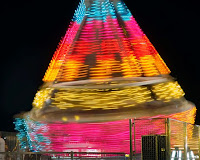 ety of styles -- portraits, landscapes, sunsets/sunrises, buildings, animals, rural scenes, landmarks, cars and trucks, bridges, trains, light optics (the amusement ride, slow shutter shots) and night shots. Do you have a favorite, or two or three favorites "types" of shots? Do you have an area you feel you're strongest in? Which give(s) you the most satisfaction?
ety of styles -- portraits, landscapes, sunsets/sunrises, buildings, animals, rural scenes, landmarks, cars and trucks, bridges, trains, light optics (the amusement ride, slow shutter shots) and night shots. Do you have a favorite, or two or three favorites "types" of shots? Do you have an area you feel you're strongest in? Which give(s) you the most satisfaction?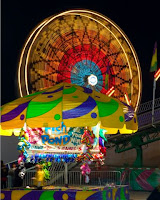
I like playing with light and motion, that's my fun time shooting right there. I'm pretty much a night owl, so I gravitate to night shots sort of naturally.
You are a member of the Indianapolis photography organization Flickr Meetup. Can you describe what role the the group and its various outings and meetings have played, or the value of the ability to share kinship and knowledge with other photographers, in the development of your skills, the appreciation of your craft and/or the awareness of your techniques?
I'm not as active in the Flickr Meetup group as I would like to be. Work and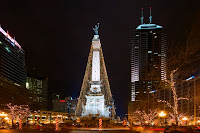 my plain old forgetfulness gets in the way. It doesn't help that Flickr has made the groups one click deeper to get to (Flickr made the group's online access site less prominent, requiring another click or two to see if there was any activity. It's less convenient to monitor them, now).
my plain old forgetfulness gets in the way. It doesn't help that Flickr has made the groups one click deeper to get to (Flickr made the group's online access site less prominent, requiring another click or two to see if there was any activity. It's less convenient to monitor them, now).
I've missed a lot of stuff because I sometimes don't think to go look on my own. Again, that's my fault; there are an awful lot of good people there who are very caring and sharing.
Have you ever had any of your work displayed in an exhibit? If not, would you like to? Does the Flickr group do anything to help spotlight members' work in any way?
I had an exhibit at the Berlin American Art Fair in 1978 or 1979. I usually don't go out for those things too much, especially when we have online resources like Flickr, Picasa and individual Web sites nowadays. I have seen some recent messages on the Indy Flickr group indicating some interest in displaying prints.
To see more of Phil's work, visit the following site:
Flickr sets/photostream
 developing, for example. A lot of my learning was self-directed; I've always had an autodidactic streak. I spent a lot of time in the library reading Ansel Adams, etc.
developing, for example. A lot of my learning was self-directed; I've always had an autodidactic streak. I spent a lot of time in the library reading Ansel Adams, etc.Speaking of Adams, I'll ask you another question I ask all the shooters in my Q&A features: Do you have any favorite photographers -- either whose work you've followed locally or from afar through the years ... or who may have inspired you to a significant degree?
Well, photographers and artists ... Adams, Jerry Uelsmann, any number of the National Geographic pros over the years. Weegee and his New York crime scene photos. There's an immediacy there that's compelling. O. Winston Link and his photos from the last days of steam on the Norfolk and Western Railroad is a particular favorite.
 How was it that you ended up living in so many places in the world ... and that you ended up back in Indianapolis? Do you have a lot of images from your world travels?
How was it that you ended up living in so many places in the world ... and that you ended up back in Indianapolis? Do you have a lot of images from your world travels?Well, most of that travel was courtesy of Uncle Sam. I lived in Thailand, Germany and Hawaii and visited many other countries in the course of my duties. I don't have as many images as one would think, partially because a container with my belongings was lost overboard during a move, and I lost about 20,000 negatives and slides. That was so personally devastating to me that I quit altogether for a number of years. I eventually came back here to be closer to my children.
You are my first Indianapolis profile for this feature, so considering you've done a lot of traveling,
 I thought you'd be a good person to ask the following: How would you size up Indianapolis and its community as photographic subjects -- its people, places, landscapes, charm -- or any other attribute you can think of? Are there any shoots of yours locally in particular you are most pleased with? Have you had any hellacious experiences on a local shoot?
I thought you'd be a good person to ask the following: How would you size up Indianapolis and its community as photographic subjects -- its people, places, landscapes, charm -- or any other attribute you can think of? Are there any shoots of yours locally in particular you are most pleased with? Have you had any hellacious experiences on a local shoot? Indianapolis has lots to offer the photographer -- everything from the quiet gardens of the art museum to the downtown canal (one of my favorite places!) to beautiful parks and the public gardens at Garfield Park. There are great people here, too. If you can't find something interesting to shoot here, you're not even trying! I've never had a problem shooting here, although I've run across some ... unusual people.
Indianapolis has lots to offer the photographer -- everything from the quiet gardens of the art museum to the downtown canal (one of my favorite places!) to beautiful parks and the public gardens at Garfield Park. There are great people here, too. If you can't find something interesting to shoot here, you're not even trying! I've never had a problem shooting here, although I've run across some ... unusual people.How difficult, or easy, was it for you to make the transition into digital photography? Do you still dabble in film? If so, do you also do your own lab work? I've chatt
 ed recently with people who did lots of film work and are lamenting the disappearance (and staying/preservation power) of Kodachrome. Are you one of those?
ed recently with people who did lots of film work and are lamenting the disappearance (and staying/preservation power) of Kodachrome. Are you one of those?Digital photography was hard for me, at first. I dabbled with the early cameras before 2001 or so and decided that it wasn't ready for prime time, so I stuck with my 25-year-old Minolta. I made a couple forays into point and shoots, but it wasn't until the Nikon D70/Canon Rebel era that I got interested in digital again.
I still have one film camera -- a Nikon N80. I haven't used it in a while. I ha
 ve no room or desire to have a wet lab again. With reference to Kodachrome: I never used it much, having at one time a preference for the Agfa and Fuji colors. I did tons of Ektachrome over the years.
ve no room or desire to have a wet lab again. With reference to Kodachrome: I never used it much, having at one time a preference for the Agfa and Fuji colors. I did tons of Ektachrome over the years.Digital files have the possibility of being preserved for a very long time if we work at it. I remember early Sony cams that got one photo on a floppy disk, and now we get tens of thousands on cheap hard disks -- so cheap that I keep all my stuff backed up on three separate drives.
You use your Web site not only to display the cream of your work but, it seems, to instruct and enc
 ourage. I remember seeing, for example, a reference to how one of the best pieces of advice you could give a photographer is to shoot close and shoot wide (see accompanying images of the longboat and "roadkill view" front auto grill). Do you really think in those terms when you approach every shot before deciding if it is the best approach for that shot?
ourage. I remember seeing, for example, a reference to how one of the best pieces of advice you could give a photographer is to shoot close and shoot wide (see accompanying images of the longboat and "roadkill view" front auto grill). Do you really think in those terms when you approach every shot before deciding if it is the best approach for that shot?Most of the time, I try to. I do apply generalities,
 however. Indoors, for example, I'm likely to shoot wide-angle just because of the limited room, and I'm going to be close anyway. For flowers, I know I'm going to probably use something in the 150-300mm range, to isolate and decrease depth of field. For architecture and outside scenes, I try to let the subject dictate what I use.
however. Indoors, for example, I'm likely to shoot wide-angle just because of the limited room, and I'm going to be close anyway. For flowers, I know I'm going to probably use something in the 150-300mm range, to isolate and decrease depth of field. For architecture and outside scenes, I try to let the subject dictate what I use."Get Close and Go Wide" works for me. It's one of my personal philosophies because I feel it opens up a lot of relational space in the frame. It might not work for everyone, but I feel like a lot of photos don't live up to their potential with a more timid approach.
Many photographers have a vision of the final product before, or as, they set up the picture. You allude to that a couple times, for example, in the captions of some of the rural or abandoned building shots that I saw at your Web site. Would you say you're able to do that most of the time? If not, what percentage of the time do you not decide how to process, or finish, an image in post-processing until you have it up on your editing software?
 Well, it's easy enough to say that black-and-white post-processing is going to be where something is going to end up if it's a monochromatic subject with interesting textures and contrast. Sometimes, I'll switch horses midstream, playing on Photoshop with different crops or contrast curves, to see what works best. I have a bunch of non-standard tool settings that I've developed that fit my style. I'd say it's probably 75 percent pre-planned and 25 percent serendipity.
Well, it's easy enough to say that black-and-white post-processing is going to be where something is going to end up if it's a monochromatic subject with interesting textures and contrast. Sometimes, I'll switch horses midstream, playing on Photoshop with different crops or contrast curves, to see what works best. I have a bunch of non-standard tool settings that I've developed that fit my style. I'd say it's probably 75 percent pre-planned and 25 percent serendipity.Regarding t
 he challenge to shoot wide and close ... what kind of wide-angle lens options do have to pick from? Do you have a favorite? And speaking of equipment, what types of camera bodies do you have and/or use regularly? And is any one of those also your all-time favorite? If not, what is?
he challenge to shoot wide and close ... what kind of wide-angle lens options do have to pick from? Do you have a favorite? And speaking of equipment, what types of camera bodies do you have and/or use regularly? And is any one of those also your all-time favorite? If not, what is?I don't actually own a wide variety of lenses. The 18mm setting on my 18-70 kit lens is often wide enough, and if not, I go to my Sigma 10-20. The 10-20mm is my go-to lens for automobile photography. I use Nikon bodies; for me it's strictly a matter of ergonomics -- they feel better in my hand. I try not to overspend on equipment: I still have and use a D50. My main camera is a D80. I never take sides in the brand warfare; I think everyone should choose their cameras for their own reasons.
I recently read through a lengthy photo group discussion thread at an online business networking site ("Linked-In,
 if you're familiar with it). A group member asked fellow photographers if and when a photograph can be labeled "fine art." Some shooters said that the degree of photo editing involved in post-processing determined the definition for them. How do you feel about pictures -- images -- being classified as "fine art?" Do you think all images can be termed fine art, and if you think not, at what point does an image become fine art?
if you're familiar with it). A group member asked fellow photographers if and when a photograph can be labeled "fine art." Some shooters said that the degree of photo editing involved in post-processing determined the definition for them. How do you feel about pictures -- images -- being classified as "fine art?" Do you think all images can be termed fine art, and if you think not, at what point does an image become fine art?Art is a subjective term, and "fine art" is an over-qualification. Beauty is in the eye of the beholder,
 and art is something intangible. It's inherent in what you see in something. I believe everyone has the innate capability to be an artist in some manner, and I'd be the last person to draw a line as to where art starts or ends.
and art is something intangible. It's inherent in what you see in something. I believe everyone has the innate capability to be an artist in some manner, and I'd be the last person to draw a line as to where art starts or ends.Along the same line, when you do your post-processing, do you have a personal "rule" or line that you don't cross when it comes to enhancing images? Also what Photoshop features do you find yourself either utilizing -- or appreciating -- the most? Are there any other photo editing software programs you use regularly and/or regard as important or crucial in your workflow? Lightroom, for example? Or any of the noise-removal programs (or plug-ins)?

I try not to get too heavy-handed, and try to avoid the standard "art" filters that come with programs like Photoshop. I'm more "nuts and bolts" in my approach and will work with the underlying layers. Sometimes I fail; that's part of the process, too. I try to shoot to avoid noise in the first place -- if there's not enough light, I'll try to find more somehow. I went to a workshop in Berlin once with a German photographer, who told me he used only available light. Later in the day, he pulled out a Vivitar flash. Noting the look on my face, he told me, "Is light. Is available."
The layer masks and blend modes in Photoshop are nothing short of miraculous to an old-timer like me. I still discover new things I can do every day. LAB mode is a huge help, for a million reasons.
You shoot a vari
 ety of styles -- portraits, landscapes, sunsets/sunrises, buildings, animals, rural scenes, landmarks, cars and trucks, bridges, trains, light optics (the amusement ride, slow shutter shots) and night shots. Do you have a favorite, or two or three favorites "types" of shots? Do you have an area you feel you're strongest in? Which give(s) you the most satisfaction?
ety of styles -- portraits, landscapes, sunsets/sunrises, buildings, animals, rural scenes, landmarks, cars and trucks, bridges, trains, light optics (the amusement ride, slow shutter shots) and night shots. Do you have a favorite, or two or three favorites "types" of shots? Do you have an area you feel you're strongest in? Which give(s) you the most satisfaction?
I like playing with light and motion, that's my fun time shooting right there. I'm pretty much a night owl, so I gravitate to night shots sort of naturally.
You are a member of the Indianapolis photography organization Flickr Meetup. Can you describe what role the the group and its various outings and meetings have played, or the value of the ability to share kinship and knowledge with other photographers, in the development of your skills, the appreciation of your craft and/or the awareness of your techniques?
I'm not as active in the Flickr Meetup group as I would like to be. Work and
 my plain old forgetfulness gets in the way. It doesn't help that Flickr has made the groups one click deeper to get to (Flickr made the group's online access site less prominent, requiring another click or two to see if there was any activity. It's less convenient to monitor them, now).
my plain old forgetfulness gets in the way. It doesn't help that Flickr has made the groups one click deeper to get to (Flickr made the group's online access site less prominent, requiring another click or two to see if there was any activity. It's less convenient to monitor them, now).I've missed a lot of stuff because I sometimes don't think to go look on my own. Again, that's my fault; there are an awful lot of good people there who are very caring and sharing.
Have you ever had any of your work displayed in an exhibit? If not, would you like to? Does the Flickr group do anything to help spotlight members' work in any way?
I had an exhibit at the Berlin American Art Fair in 1978 or 1979. I usually don't go out for those things too much, especially when we have online resources like Flickr, Picasa and individual Web sites nowadays. I have seen some recent messages on the Indy Flickr group indicating some interest in displaying prints.
To see more of Phil's work, visit the following site:
Flickr sets/photostream
No comments:
Post a Comment